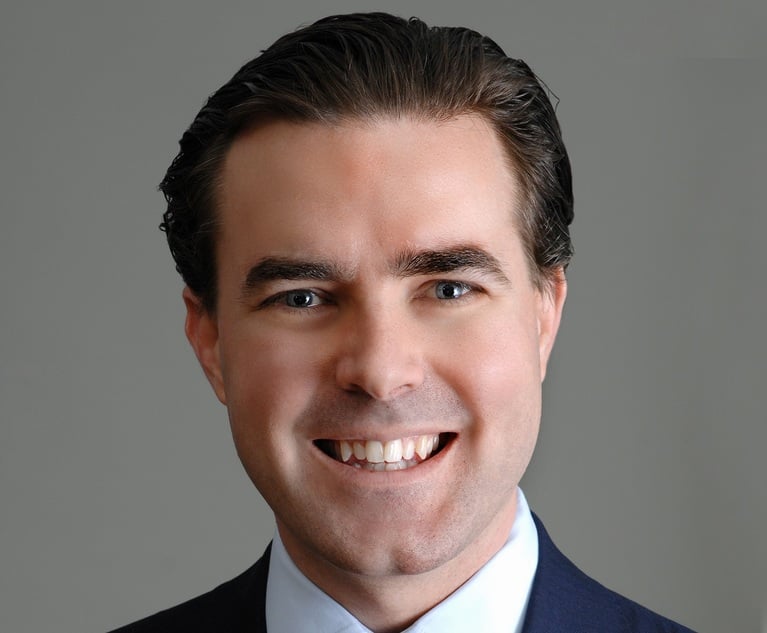NY Firm's Financial Woes May Point to Pitfalls of Rapid Lateral Growth
CKR Law, which is struggling to pay partners, now says it's taking steps to "right-size." Sources say some there have gone at least three months without regular partner draws.
May 20, 2019 at 05:45 PM
6 minute read
The original version of this story was published on The American Lawyer
 Photo: Shutterstock
Photo: Shutterstock
CKR Law, founded five years ago in New York, has spent much of its short existence expanding its reach beyond the state, the country and even the hemisphere.
In January 2018 it announced its “rapid expansion” through office openings in Orange County and San Diego in California. A month later, the firm said it had added even more partners by opening offices in Philadelphia, Seattle and Wilmington, Delaware. By July it had its first Texas office. The same month, it established “strategic locations” in Estonia, Switzerland, Turkey and, in the same breath, Wyoming.
The firm now boasts at least 50 locations on five continents. But by this spring, its managing partner, Jeffrey Rinde, was sending messages to partners about why they hadn't received their draws yet, according to internal emails viewed by ALM.
CKR, which lists more than 200 lawyers on its website, faces a “cash flow crunch” and plans to make cuts, including letting go underperforming partners and reducing expenses, according to a May 10 internal email. And some partners weren't paid May 15, meaning they have gone at least three months without their anticipated partner draws, sources close to the firm told ALM.
Law firms often boast that they are in growth mode, whether by adding new offices, new partners or new practices. And while CKR asserts its cash shortfall is unrelated, its swift expansion may still serve as a warning of the potential risks that come with rapid growth through lateral additions.
To be clear, rapid lateral growth is not inherently reckless: Some successful Am Law 200 firms add laterals almost every week or open locations in far-flung locales around the world by acquiring local shops.
Kent Zimmermann, a Zeughauser Group law firm management consultant, speaking generally on the legal industry, said he doesn't see fast expansion alone as a chronic problem in the industry. But growth through unsuccessful lateral hires or adding laterals without a core strategy is a widespread problem, Zimmermann said.
Based on what he's heard from law firm leaders, only about a third of lateral partner hires, on average, are successful after 18 months. “Laterals don't work out most of the time, and if you only grow with laterals, many firms are coming to the conclusion that that's a slow, error-prone, expensive way to grow, and that's partly why you see so many firms putting mergers on the table,” Zimmermann said.
The problems stem from vetting laterals incorrectly and not having a core strategy about who to pursue and which practice areas, Zimmermann said.
It's not only about adding laterals with portable client business. If the lateral partner has his or her own book of business but isn't complementary to the firm's specific strategy or specialization, “it's pretty hard to see how that will ever work,” said David Barnard, a firm consultant at Blaqwell, also speaking generally.
Some firms aim to reach a certain head count—say 500 or 1,000 lawyers—but there's no number that suddenly makes a law firm more profitable or more successful, and there's no data to indicate that firms become more profitable as they get bigger, said Altman Weil law firm consultant Tom Clay. “It's that kind of thinking that could get people in trouble,” Clay said about firms setting arbitrary head count goals.
“There is some merit in having more critical mass if your clients need it but … there's no statistics or history to tell you being a 100 lawyers versus 400 versus 600 is a benefit to you” or helps a law firm's profits, Clay said. “You need to match your size with your market.”
For its part, CKR disputes that its speedy growth rate caused its financial struggles this year. “We do not believe our rapid growth materially contributed to the cash flow circumstances intimated in the press,” said Rinde, the managing partner, in a statement to ALM on Friday.
Rinde's statement only vaguely addressed what he described as the “root cause” of the firm's situation: He said it related to ”non-recurring events which caused certain contractually committed revenues owed to the firm to be deferred” beyond the first quarter this year.
“We have already taken appropriate steps to remedy this issue and prevent any recurrence. We expect these delayed revenues will be realized during the course of 2019 and expect to achieve our 2019 revenue and profit goals,” Rinde said.
'Right-sizing'
A look at CKR's lateral announcements shows a wide array of practices of its new hires in the last two years, including immigration, tax, real estate, blockchain, finance, IP, bankruptcy and litigation. Many were formerly solo practitioners or practiced at small firms. Overall, the firm announced the addition of about 58 lawyers in 2018 alone.
 Screenshot of CKR Law website
Screenshot of CKR Law websiteRinde's statement Friday said that although he believes the firm's lateral success rate “exceeds industry standards,” CKR is now “right-sizing, in part, by terminating relationships with underperforming partners.” CKR, he said, will also revise its arrangements with “certain other attorneys to be more consistent with their individual performance.”
CKR's internal emails this month acknowledge that some attorneys “failed to bill hundreds of thousands of dollars' worth of time,” money that could have been used to pay some outstanding draws.
Retaining unproductive nonequity partners is an industrywide phenomenon. A new Altman Weil study showed firm leaders believed 51% of nonequity partners are not sufficiently busy. That's an “egregious” number, Clay said.
The survey also showed that more than half of firm leaders thought overcapacity was diluting their firms' profitability, yet the vast majority of firm leaders said they would pursue growth through lateral hires in 2019.
As ALM reported last week, many partners at CKR haven't been paid at least two months of their regularly anticipated draws. May 15 for some marked their third month without a regular draw, multiple sources said.
Rinde's statement to ALM obliquely addresses this, noting “some contract partners may be disappointed with the firm's decisions concerning their ongoing relationship with CKR, including timing and payment of draws” and “the adherence to firm policies as a pre-condition to payment.”
But despite the financial struggles and its plans to reduce expenses, CKR is still in talks to add more laterals. Rinde told ALM that the firm will evaluate lateral opportunities, including individual partners, practice groups or firms. “Certain lateral partners and groups have recently joined the firm and we expect other prospects to join in the near term,” Rinde's statement said. He said CKR has “no outside debt.”
“We have received assurances from the vast majority of our partners of their commitment to the firm and our continued success,” Rinde' statement added. “We believe our underlying business model is sound.”
Jack Newsham contributed to this report.
This content has been archived. It is available through our partners, LexisNexis® and Bloomberg Law.
To view this content, please continue to their sites.
Not a Lexis Subscriber?
Subscribe Now
Not a Bloomberg Law Subscriber?
Subscribe Now
NOT FOR REPRINT
© 2025 ALM Global, LLC, All Rights Reserved. Request academic re-use from www.copyright.com. All other uses, submit a request to [email protected]. For more information visit Asset & Logo Licensing.
You Might Like
View All
DLA Piper NY Office Adds Ex-Verizon GC As Big Law Goes on In-House Hiring Spree
Trending Stories
- 1Stevens & Lee Names New Delaware Shareholder
- 2U.S. Supreme Court Denies Trump Effort to Halt Sentencing
- 3From CLO to President: Kevin Boon Takes the Helm at Mysten Labs
- 4How Law Schools Fared on California's July 2024 Bar Exam
- 5'Discordant Dots': Why Phila. Zantac Judge Rejected Bid for His Recusal
Who Got The Work
Michael G. Bongiorno, Andrew Scott Dulberg and Elizabeth E. Driscoll from Wilmer Cutler Pickering Hale and Dorr have stepped in to represent Symbotic Inc., an A.I.-enabled technology platform that focuses on increasing supply chain efficiency, and other defendants in a pending shareholder derivative lawsuit. The case, filed Oct. 2 in Massachusetts District Court by the Brown Law Firm on behalf of Stephen Austen, accuses certain officers and directors of misleading investors in regard to Symbotic's potential for margin growth by failing to disclose that the company was not equipped to timely deploy its systems or manage expenses through project delays. The case, assigned to U.S. District Judge Nathaniel M. Gorton, is 1:24-cv-12522, Austen v. Cohen et al.
Who Got The Work
Edmund Polubinski and Marie Killmond of Davis Polk & Wardwell have entered appearances for data platform software development company MongoDB and other defendants in a pending shareholder derivative lawsuit. The action, filed Oct. 7 in New York Southern District Court by the Brown Law Firm, accuses the company's directors and/or officers of falsely expressing confidence in the company’s restructuring of its sales incentive plan and downplaying the severity of decreases in its upfront commitments. The case is 1:24-cv-07594, Roy v. Ittycheria et al.
Who Got The Work
Amy O. Bruchs and Kurt F. Ellison of Michael Best & Friedrich have entered appearances for Epic Systems Corp. in a pending employment discrimination lawsuit. The suit was filed Sept. 7 in Wisconsin Western District Court by Levine Eisberner LLC and Siri & Glimstad on behalf of a project manager who claims that he was wrongfully terminated after applying for a religious exemption to the defendant's COVID-19 vaccine mandate. The case, assigned to U.S. Magistrate Judge Anita Marie Boor, is 3:24-cv-00630, Secker, Nathan v. Epic Systems Corporation.
Who Got The Work
David X. Sullivan, Thomas J. Finn and Gregory A. Hall from McCarter & English have entered appearances for Sunrun Installation Services in a pending civil rights lawsuit. The complaint was filed Sept. 4 in Connecticut District Court by attorney Robert M. Berke on behalf of former employee George Edward Steins, who was arrested and charged with employing an unregistered home improvement salesperson. The complaint alleges that had Sunrun informed the Connecticut Department of Consumer Protection that the plaintiff's employment had ended in 2017 and that he no longer held Sunrun's home improvement contractor license, he would not have been hit with charges, which were dismissed in May 2024. The case, assigned to U.S. District Judge Jeffrey A. Meyer, is 3:24-cv-01423, Steins v. Sunrun, Inc. et al.
Who Got The Work
Greenberg Traurig shareholder Joshua L. Raskin has entered an appearance for boohoo.com UK Ltd. in a pending patent infringement lawsuit. The suit, filed Sept. 3 in Texas Eastern District Court by Rozier Hardt McDonough on behalf of Alto Dynamics, asserts five patents related to an online shopping platform. The case, assigned to U.S. District Judge Rodney Gilstrap, is 2:24-cv-00719, Alto Dynamics, LLC v. boohoo.com UK Limited.
Featured Firms
Law Offices of Gary Martin Hays & Associates, P.C.
(470) 294-1674
Law Offices of Mark E. Salomone
(857) 444-6468
Smith & Hassler
(713) 739-1250









